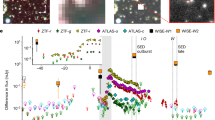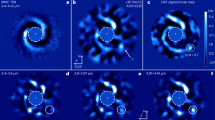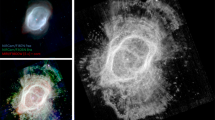Abstract
Many lines of reasoning suggest that external galaxies should host planetary systems, but detecting them by methods typically used in our own Galaxy is not possible. An alternative approach is to study the temporal behaviour of X-rays emitted by bright extragalactic X-ray sources, where an orbiting planet would temporarily block the X-rays and cause a brief eclipse. We report on such a potential event in the X-ray binary M51-ULS-1 in the galaxy M51. We examined a range of explanations for the observed X-ray dip, including a variety of transiting objects and enhancements in the density of gas and dust. The latter are ruled out by the absence of changes in X-ray colours, save any with sharp density gradients that cannot be probed with our data. Instead, the data are well fit by a planet transit model in which the eclipser is most likely to be the size of Saturn. We also find that the locations of possible orbits are consistent with the survival of a planet bound to a mass-transfer binary.
This is a preview of subscription content, access via your institution
Access options
Access Nature and 54 other Nature Portfolio journals
Get Nature+, our best-value online-access subscription
$29.99 / 30 days
cancel any time
Subscribe to this journal
Receive 12 digital issues and online access to articles
$119.00 per year
only $9.92 per issue
Buy this article
- Purchase on Springer Link
- Instant access to full article PDF
Prices may be subject to local taxes which are calculated during checkout






Similar content being viewed by others
Data availability
The Chandra and XMM-Newton data that support the findings of this study are available from the Chandra Data Archive site https://cda.harvard.edu/chaser/ and the HEASARC website https://heasarc.gsfc.nasa.gov/docs/archive.html, respectively. The ObsIDs of the 24 observations employed in this work are listed in Extended Data Fig. 1, which images a table of the X-ray observations.
Code availability
We have made available all scripts and extracted data used to run the MCMC and hardness ratio analyses in a Google Drive folder at https://drive.google.com/drive/folders/1c1O8q8wokWPbyNxRnkpxYS7OeBFmL_80?usp=sharing hosted by the Center for Astrophysics | Harvard & Smithsonian. The scripts use several routines in PINTofALE https://hea-www.harvard.edu/PINTofALE/. The hardness ratio code BEHR, used in the ‘Nature of the X-ray dip’ section, is available at https://hea-www.harvard.edu/AstroStat/BEHR/.
References
Imara, N. & Di Stefano, R. Searching for exoplanets around X-ray binaries with accreting white dwarfs, neutron stars, and black holes. Astrophys. J. 859, 40 (2018).
Jaodand, A., Hessels, J. W. T. & Archibald, A. A decade of transitional millisecond pulsars. In Proc. International Astronomical Union Symposium 337 Vol. 13 (eds Weltevrede, P. et al.) 47–51 (Cambridge Univ. Press, 2018)..
Wolszczan, A. Discovery of pulsar planets. New Astron. Rev. 56, 2–8 (2012).
Lorimer, D. Binary and millisecond pulsars. Living Rev. Relativ. 11, 8 (2008).
Ford, E. B., Joshi, K. J., Rasio, F. A. & Zabarsky, B. Theoretical implications of the PSR B1620-26 triple system and its planet. Astrophys. J. 528, 336–350 (2000).
Di Stefano, R. & Kong, A. K. H. Luminous supersoft X-ray sources in external galaxies. Astrophys. J. 592, 884–899 (2003).
Urquhart, R. & Soria, R. Optically thick outflows in ultraluminous supersoft sources. Mon. Not. R. Astron. Soc. 456, 1859–1880 (2016).
Terashima, Y., Inoue, H. & Wilson, A. S. Hubble Space Telescope identification of the optical counterparts of ultraluminous X-ray sources in M51. Astrophys. J. 645, 264–270 (2006).
Rappaport, S. A., Podsiadlowski, P. & Pfahl, E. Stellar-mass black hole binaries as ultraluminous X-ray sources. Mon. Not. R. Astron. Soc 356, 401–414 (2005).
Parmar, A. N., White, N. E., Giommi, P. & Gottwald, M. The discovery of 3.8 hour periodic intensity dips and eclipses from the transient low-mass X-ray binary EXO 0748-676. Astrophys. J. 308, 199–212 (1986).
Gambino, A. et al. Updating the orbital ephemeris of the dipping source XB 1254-690 and the distance to the source. Res. Astron. Astrophys. 17, 108 (2017).
Church, M. J. et al. Progressive covering in dipping and Comptonization in the spectrum of XB 1916-053 from the BeppoSAX observation. Astron. Astrophys. 338, 556–562 (1998).
Humphrey, P. J., Church, M. J., Baucińska-Church, M. & Parmar, A. N. Spectral evolution during dipping in X 1624-490 from the BeppoSAX observation. AIP Conf. Proc. 599, 658–661 (2001).
Park, T. et al. Bayesian estimation of hardness ratios: modeling and computations. Astrophys. J. 652, 610–628 (2006).
Greiner, J. & Di Stefano, R. X-ray off states and optical variability in CAL 83. Astron. Astrophys. 387, 944–954 (2002).
Bayliss, D. et al. NGTS-1b: a hot Jupiter transiting an M-dwarf. Mon. Not. R. Astron. Soc. 475, 4467–4475 (2018).
Barffe, I., Chabrier, G., Barman, T. S., Allard, F. & Hauschildt, P. H. Evolutionary models for cool brown dwarfs and extrasolar giant planets. The case of HD 209458. Astron. Astrophys. 402, 701–712 (2003).
Stevens, D. J. et al. An extreme-mass ratio, short-period eclipsing binary consisting of a B dwarf primary and a pre-main-sequence M star companion discovered by KELT. Mon. Not. R. Astron. Soc. 499, 3775–3791 (2020).
Triaud, A. H. M. J. et al. The EBLM Project. IV. Spectroscopic orbits of over 100 eclipsing M dwarfs masquerading as transiting hot Jupiters. Astron. Astrophys. 608, A129 (2017).
Carmichael, T. W., Latham, D. W. & Vanderburg, A. M. New substellar discoveries from Kepler and K2: is there a brown dwarf desert? Astron. J. 158, 38 (2019).
Owen, J. E. & Campos Estrada, B. Testing exoplanet evaporation with multitransiting systems. Mon. Not. R. Astron. Soc. 491, 5287–5297 (2020).
Poppenhaeger, K., Ketzer, L. & Mallonn, M. X-ray irradiation and evaporation of the four young planets around V1298 Tau. Mon. Not. R. Astron. Soc. 500, 4560–4572 (2021).
Sanz-Forcada, J., Desidera, S. & Micela, G. Effects of X-ray and extreme UV radiation on circumbinary planets. Astron. Astrophys. 570, A50 (2014).
Fruscione, A. et al. CIAO: Chandra’s data analysis system. In Proc. Society of Photo-Optical Instrumentation Engineers (SPIE) Conference on Astronomical Telescopes and Instrumentation Vol. 6270 (eds Silva, D. R. & Doxsey, R. E.) (SPIE, 2006).
Blackburn, J. K. FTOOLS: a FITS data processing and analysis software package. ASP Conf. Ser. 77, 367–370 (1995).
Wang, S., Soria, R., Urquhart, R. & Liu, J. Discovery of two eclipsing X-ray binaries in M 51. Mon. Not. R. Astron. Soc. 477, 3623–3645 (2018).
Urquhart, R. & Soria, R. Two eclipsing ultraluminous X-Ray sources in M51. Astrophys. J. 831, 56 (2016).
Irwin, J. et al. Ultraluminous X-ray bursts in two ultracompact companions to nearby elliptical galaxies. Nature 538, 356–358 (2016).
Gelman, A. et al. Bayasian Data Analysis 3rd edn (CRC Press, 2013).
Kaastra, J. S. On the use of C-stat in testing models for X-ray spectra. Astron. Astrophys. 605, A51 (2017).
Einstein, A. Lens-like action of a star by the deviation of light in a gravitational field. Science 84, 506–507 (1936).
Eggleton, P. P. Approximations to the radii of Roche lobes. Astrophys. J. 268, 368–369 (1983).
Abbott, B. P. et al. Astrophysical implications of the binary black hole merger GW150914. Astrophys. J. Lett. 818, L22 (2016).
Foucart, F. & Lai, D. Evolution of linear warps in accretion discs and applications to protoplanetary discs in binaries. Mon. Not. R. Astron. Soc. 445, 1731–1744 (2014).
Orosz, J. A. et al. Discovery of a third transiting planet in the Kepler-47 circumbinary system. Astron. J. 157, 174 (2019).
Acknowledgements
R.D. thanks D. D’Orazio and T. Hutchinson-Smith for relevant discussions and input on the analysis of X-ray light curves. She would also like to thank A. Burrows and D. Charkrabarty for discussions about the models, and D. Latham for a discussion about the light curve interpretation. We thank P. Edmonds and M. Watzke for useful discussions. J.B. thanks D. Alp for discussion and help with software in the process of analysing images, and the Center for Excellence in Education’s Research Science Institute for enabling collaboration with R.D. T.W.C. thanks D. Latham and his research group for discussions and guidance on transiting brown dwarfs. V.L.K. thanks T. Gaetz and P. Sharda for useful discussions on the maths of overlapping circles. V.L.K. acknowledges support from NASA contract NAS8-03060 to the Chandra X-ray Center. T.W.C. thanks the National Science Foundation Graduate Research Fellowships Program for providing funding for this work. N.I. thanks the John Harvard Distinguished Science Fellows Program for research support.
Author information
Authors and Affiliations
Contributions
R.D. initiated and coordinated the work, recruited the team, conducted initial fits to the X-ray light curve and worked on all elements of the modelling and interpretation, as well as on the manuscript. J.B. participated in our initial analysis of the X-ray light curves discovering the short eclipse; she found a journal article (authored by R.U. and R.D.) in which the eclipse light curve was shown but not analysed. She participated in many aspects of the complete analysis as well as in manuscript preparation. R.U. downloaded, processed and analysed all of the X-ray data used in this project. He plotted and studied both the long-term and short-term light curves and provided the information and background needed to interpret the data. R.S. provided input into the relation between the XRS M51-ULS-1, the model for this source, and its connection to other XRSs. He contributed to key elements of the modelling and interpretation. V.L.K., an expert in astrostatistics and X-ray data analysis, did the MCMC fit and Bayesian hardness ratio analysis, made several figures, worked on the text in various places and provided crucial advice on various model elements. T.W.C., an expert in brown-dwarf transits, developed the input and figures on astrophysical objects with sizes similar to those of the candidate exoplanet. He also played a significant role in preparing the manuscript for publication. N.I., an expert in star formation, worked on the binary and planet models and provided necessary input on star formation.
Corresponding author
Ethics declarations
Competing interests
The authors declare no competing interests.
Additional information
Peer review information Nature Astronomy thanks the anonymous reviewers for their contribution to the peer review of this work.
Publisher’s note Springer Nature remains neutral with regard to jurisdictional claims in published maps and institutional affiliations.
Extended data
Extended Data Fig. 1
X-Ray Observation.
Extended Data Fig. 2
X-Ray Count Rates.
Extended Data Fig. 3 Sparklines.
Sparklines of light curves from variable sources in M51 with >800 counts found in Chandra ObsID 13814. The x-axis covers the same time range as in the bottom panel of Figure 1. The total counts in each light curve is shown at left. The source we focus on here, M51-ULS-1, is the fifth from the top, with 2213 counts. Other sources of note include the ingress of an eclipsing ULX(ULX-1 from27, fourth from bottom, with 1489 counts), and an eclipsing neutron star XRB(S2 from26, at bottom, with 803 counts).
Extended Data Fig. 4 Accretion Dips.
Exemplar X-ray observations of accretion-related dips, showing the background subtracted light curves in several bands in the upper part of each panel, and the spectral colour in the lower part. The sources shown are: Panel (a); a double-dip found in M51-ULS-1 (XMM-Newton observation 303420201); Panel (b): M101-ULS (Chandra ObsID 4737); Panel (c): M101-ULS (Chandra ObsID 5338). The black light curves are for the broad band (0.2-10 keV), comprised of the soft (S=0.2:0.7 keV; orange histograms) and hard (H=0.7:10 keV; blue histograms) passbands. The corresponding spectral colour \(C={{\mathrm{log}}}\,\frac{S}{H}\) is shown in the lower part of each panel, with 90% highest-posterior density (HPD) error bars estimated using Park et al.14. The average colour over some intervals of interest corresponding to light curve behavior are shown as the shaded regions. Unlike the short-duration event seen in M51-ULS-1 (see Figure 4), the intensity variations are stochastic and the spectrum displays variations correlated with intensity.
Extended Data Fig. 5 The Transit.
The putative eclipse event studied here, shown in analogy to Extended Data Figure 4 above. The sizes of the error bars increase for low count rates, but there is no evidence for spectral variations across the transit.
Extended Data Fig. 6 Ingress to and Egress from Eclipse of M51-ULS-1 by the Donor Star.
Light curves of occultation events by the companion star. Panel (a): As in Extended Data Fig. 4, but for intervals in M51-ULS-1 that appear to show long-duration eclipse ingress during the XMM-Newton observation 824450901. Panel (b): as above, but for an eclipse egress during Chandra ObsID 13815.
Extended Data Fig. 7 X-Ray Images of the Field containing M51-ULS-1.
XMM-Newton image of M51-ULS-1 during eclipse. Panel (a): XMM-Newton/pn 0.2-10 keV image of the observation 303420201 during which M 51-ULS-1 appears active. Panel (b): as in the upper panel, but for the portion of XMM-Newton observation 824450901 in which the source is in eclipse (i.e., ~30–75 ks in Extended Data Fig. 6, top). Panel (c): stacked 0.3-7 keV Chandra/ACIS image of the same field. The 25″ radius green circles in each image is comparable to the XMM-Newton extraction region for M 51-ULS-1. It is clear from the Chandra image that a number of nearby point sources are likely contaminating the XMM-Newton extraction region for M 51-ULS-1 and may be causing the residual hard emission seen while the source is in eclipse.
Extended Data Fig. 8 Probability Distributions of the Radius of the Source.
The nominal probability distribution of RX. Panel (a) shows the differential density distributions for the conjoined half-Gaussians (orange dashed curve on left and blue dash-triple-dotted curve on right) and for a gamma distribution (green solid line). Panel (b) shows the cumulative distributions of the two candidate distributions (as in Panel (a)), along with vertical dotted lines indicating the 5% and 95% bounds of RX, and horizontal dashed lines indicating the corresponding levels. The gamma distribution matches the bounds better, but has a a slightly larger mode.
Extended Data Fig. 9 Marginalized Posterior Probablity Density Distributions of Eclipse Model Parameters.
The marginalized posterior probablity density distributions of eclipse model parameters (a) baseline count rate cX, ((b)) eclipse mid-point Tmid, ((c)) impact parameter b, and ((d)) the velocity of the eclipser. The probability density distributions are shown as thick black curves, with the vertical lines marking the mode (solid orange), 68% highest-posterior-density (HPD) bounds (dashed blue), 90% HPD bounds (dash-triple-dotted green). The values of each of these quantities, along with the mean and 1σ standard deviation (marked as the thin red horizontal bar), are printed in the legend within each panel (see also Table 1). Note that the posterior density distribution of the radius of the eclipser, Rec, is shown in Figure 5.
Extended Data Fig. 10 Joint Posterior Distributions of Pairs of Eclipse Model Parameters.
The joint posterior distributions between the parameters for the eclipser’s impact parameter b, radius fec, and velocity vpl, for (a) p(b, fec), (b) p(b, vpl), and (c) p(fec, vpl) from top to bottom. Each contour plot shows the joint density, marked at enclosed estimated probability (EE) regions for 39% (bluish green; 2D Gaussian 1σ equivalent), 67% (red; 1.5σ), 85% (sky blue; 2σ), and 95% (yellow; 2.5σ). The solid white dots indicate the mode of the distribution. Note that strong correlations are present between these parameters; see text for discussion.
Rights and permissions
About this article
Cite this article
Di Stefano, R., Berndtsson, J., Urquhart, R. et al. A possible planet candidate in an external galaxy detected through X-ray transit. Nat Astron 5, 1297–1307 (2021). https://doi.org/10.1038/s41550-021-01495-w
Received:
Accepted:
Published:
Issue Date:
DOI: https://doi.org/10.1038/s41550-021-01495-w



